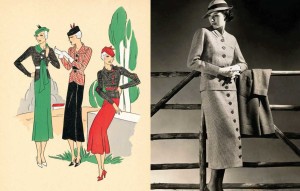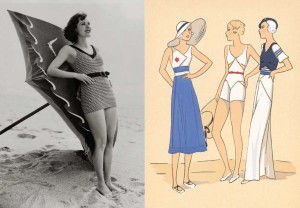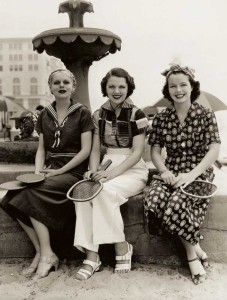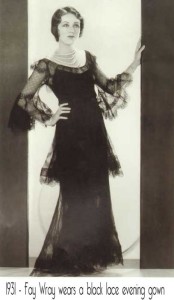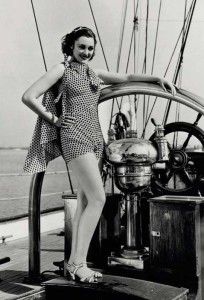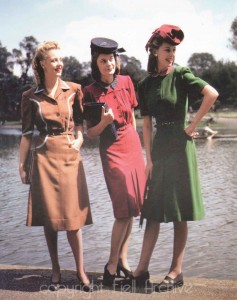Leading authority on 20th Century fashion and design – Charlotte Fiell talks to Glamourdaze.

Last year while browsing in the famous Blackwell’s bookstore in Oxford I was riveted to one spot and eventually one comfortable sofa (Blackwells is my kinda book shop) leafing through two thickly illustrated and sumptuous books by Charlotte Fiell and Emmanuelle Dirix. The 1920’s Fashion Sourcebook and The 1930’s Fashion Sourcebook.
Each book is a year by year picture story of fashion trends as they happened. Blackwell’s was closing and I decided to return the next day to buy them. Both had sold. I’ve since received the 1930s source-book – and have written a few posts about it featuring some of the exquisite images it contains. Thanks also to Rosie Nicholas of Carlton books for forwarding the brand new and exciting publication 1940’s Fashion – the Definitive Sourcebook, which I will shortly review. I’m delighted to be able to share thoughts with author and publisher Charlotte Fiell.
GD –Charlotte. I’ve just read up a little on you and your name pops up everywhere when it comes to any recommended books on design. You worked with Sotheby’s, you and your husband Peter worked as editors with Taschen, then created your own publishing empire with Fiell Publishing and now you are part of the Carlton Publishing group. How goes it all now – especially since the global recession?
C-The global crunch has certainly been a challenge for the publishing industry, along with the migration to digital, but ultimately I’m still a huge believer in the printed book. It is quite a different experience from reading off screen and provides a very necessary curatorial filter, and in many ways it is much more sensorially satisfying too.
GD –To top your successes in publishing, your lovely home is a testament to your love of the aesthetic. What triggered the idea for the vintage fashion source-books?
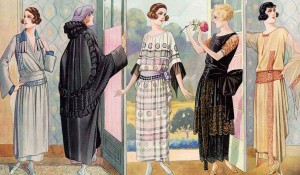
C –Even when I was about eight years old I had a passion for collecting antiques, and as a child amassed a pretty impressive collection of hatpins – from enormous Edwardian ones to short stubby Art Deco ones. This first entrée into vintage collecting gave me an early understanding of fashion styles, which later developed into a full blown passion for vintage fashion. Then as a college student, instead of having a traditional summer job I would scour charity shops, jumble sales, village fetes and car boot sales for vintage clothes and then re-sell them to a couple of vintage dealers that I knew. By doing this as “my summer job” I not only earned far more, but also learnt far more too…from the beautiful beaded flapper dresses and the 1940s mink stoles to 1950s satin and diamante winkle pickers. I also loved wearing vintage, because it was just so much more interesting than what you could then buy in the High Street.
GD –I have dozens of old 1920s and 1930s magazines, and in those days you certainly got your money’s worth – 100’s of pages. This must have been a bit like an archaeological dig?
C-Yes it was. With all the books I’ve ever done I’ve always felt a bit like a cultural archaeologist…I love digging in archives and really get a real thrill when I uncover something interesting about design or fashion that has been lost in the midst of time.
GD- How did the idea for a vintage fashion source-book originate?
C- I always felt that there was a need for a really comprehensive decade-by-decade treatment of fashion, which not only included haute couture but also ready-to-wear clothes too, so that one could get a much better idea of what women were actually wearing. I am also fascinated by the socioeconomic context of fashion, and couldn’t have found anyone more knowledgeable on the subject than my co-author, Emmanuelle Dirix, who is a mine of wonderful information and fashion stories.
GD- As a fashion blogger, I tend not to post too often, but I take many hours putting together sources while I write. Could you describe to us how these books came together?
C- I spent about two years collecting images from all over the places, and every image selected I felt had something interesting about it – whether it was a photograph, advertisement or illustration. I became almost obsessed with the detailing of clothes and tirelessly searched for images that related to say, accessories, bridal wear or lingerie so that I could really give the reader a really good insight into the “whole wardrobe” as well as the different themes that were inspiring fashion creations.
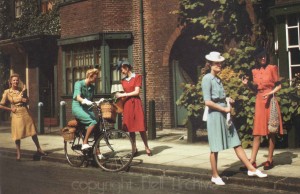
GD- How did you and Emmanuelle Dirix come to work together?
C- My daughter, Clementine did a short fashion history course at the London College of Fashion and Emmanuelle was her lecturer. She came home and said, “You have just got to a book together!” so we met up and I immediately knew she was the right person to work with on the Fashion Source-books.
GD- The books mix famous designers like Paquin, Chanel, Schiaparelli with designers I’ve never heard of – and such beautiful designs. Did you find any little known designers in particular that may have influenced fashion trends more than they were credited for?
C- Absolutely, and also it was interesting to find firm evidence that de-bunked certain fashion history myths, for example it has often been suggested that Chanel made black a fashionable color with her LBD, but actually in our researches we found that black was a fashionable color way before the LBD was introduced.
GD- From your considerable research what in your view would be the ‘top’ iconic pieces in design and clothing? Firstly for the 1920’s and then the 1930’s.
C- Oh, that is such a hard question…Certainly the jersey sportswear outfits and beaded flapper dresses of the 1920s stand out for their innovation, and as for the 1930s, the ruffled organdie dress worn by Joan Crawford in “Letty Lynton” (1932) is a veritable icon of silver screen glamour.
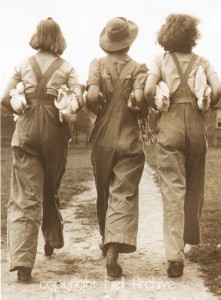
GD- What is your own personal style preference?
C- I confess I go for comfort over style these days, and am a complete American Apparel fan, but my youngest daughter who is studying fashion at Central Saint Martins has inherited my interest in vintage and has an impressive collection of amazing finds.
GD- Finally Charlotte, the big news is you have just published a 1940’s fashion book, which we’ll be reviewing soon.?
C- The “1940s Fashion: The Ultimate Sourcebook” is now available, and is even better than the first two books in the series – Emmanuelle and I have really starting hit our stride with this one. And then we’ve got in the works the 1950s, 1960s and 1970s…plus another couple of other fashion titles up our proverbial sleeves. So lots more goodies coming soon….
Thanks a million Charlotte for the chat. Stay tuned for our up coming review of Charlotte and Emmanuelle’s new book 1940s Fashion – The Definitive Sourcebook.
1940s Fashion: The Definitive Sourcebook by Emmanuelle Dirix & Charlotte Fiell is published by Goodman Fiell, RRP £30, available from www.carltonbooks.co.uk (@carltonbooks)

